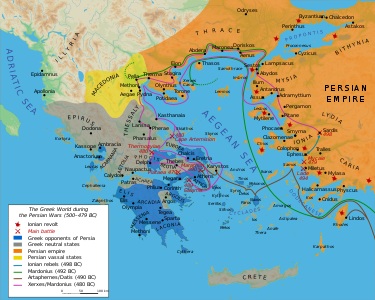هخامنشیلر دؤولتی
بو مقالهنی ویکیلشدیرمک لازیمدیر. |

هخامنشیلر دؤولتی (اسکی فارسجا: Xšassa/شاهنشاهی) — بیر اسکی شاهلیقایمیش کی ۵۵۰ م.ق – ۳۳۰ م.ق ایله کیمی حؤکۆمت سوروب. بۇ سولاله (۲۲۰ ایل) اورتاشرق منطقهسینده حؤکۆمت ائدیب.
گؤرونتولر[دَییشدیر]
قایناقلار[دَییشدیر]
- ^ Yarshater, Ehsan (1993). The Cambridge History of Iran, Volume 3. Cambridge University Press. p. 482. ISBN 978-0-521-20092-9.
Of the four residences of the Achaemenids named by هرودوت — اکباتان پاسارگاد و پرسپولیس، Susa and Babylon — the last [situated in Iraq] was maintained as their most important capital, the fixed winter quarters, the central office of bureaucracy, exchanged only in the heat of summer for some cool spot in the highlands. Under the سلوکیلر ایمپیراتورلوغو and the اشکانیلر the site of the Mesopotamian capital moved a little to the north on the دجله چایی — to Seleucia and Ctesiphon. It is indeed symbolic that these new foundations were built from the bricks of ancient Babylon, just as later بغداد، a little further upstream, was built out of the ruins of the ساسانیلر double city of Seleucia-Ctesiphon.
- ^ Harald Kittel, Juliane House, Brigitte Schultze; Juliane House; Brigitte Schultze (2007). Traduction: encyclopédie internationale de la recherche sur la traduction. Walter de Gruyter. pp. 1194–5. ISBN 978-3-11-017145-7.
{{cite book}}: CS1 maint: multiple names: authors list (link) - ^ Greek and Iranian, E. Tucker, A History of Ancient Greek: From the Beginnings to Late Antiquity, ed. Anastasios-Phoivos Christidēs, Maria Arapopoulou, Maria Chritē, (Cambridge University Press, 2001), 780.
- ^ Boiy, T. (2004). Late Achaemenid and Hellenistic Babylon. Peeters Publishers. p. 101. ISBN 978-90-429-1449-0.
- ^ Yarshater (1996, p. 47)
- ^ Security and Territoriality in the Persian Gulf: A Maritime Political Geography by Pirouz Mojtahed-Zadeh, page 119
- ^ ۷٫۰ ۷٫۱ archive copy. آرشیولنیب اصلی نۆسخهدن on 2012-01-12. یوْخلانیلیب2015-09-12.
- ^ ۸٫۰ ۸٫۱ Behistun Inscription
- ^ Josef Wiesehöfer, Ancient Persia, (I.B. Tauris Ltd, 2007), 119.
اینگیلیسجه ویکیپدیاسینین ایشلدنلری طرفیندن یارانمیش«Achaemenid_Empire»، مقالهسیندن گؤتورولوبدور. (۱۲ سپتامبر ۲۰۱۵ تاریخینده یوْخلانیلیبدیر).
اتکیازیلار[دَییشدیر]
بؤلمهلر:
- CS1 maint: multiple names: authors list
- بۆتون ویکیلشدیرمک لازیم اولان مقالهلر
- Pages using collapsible list with both background and text-align in titlestyle
- هخامنشلر
- ایراندا تاریخی سیلسیلهلر
- Achaemenid Empire
- Ancient Persia
- Iranian empires
- Monarchy in Persia and Iran
- اسکی میصر
- Articles which contain graphical timelines
- Former empires in Asia
- Former empires in Africa
- Former empires in Europe
- Persian history
- History of Iran
- History of Zoroastrianism
- اورتاشرقین تاریخی
- دوغو اوروپانین تاریخی
- قوزئی آفریقانین تاریخی
- گونئیباتی آسیانین تاریخی
- Iron Age countries in Asia
- Iron Age countries in Europe
- Countries in ancient Africa
- Patronymics
- Superpowers
- 6th century BC in Iran
- 5th century BC in Iran
- 4th century BC in Iran
- 550s BC
- 330s BC
- States and ter












































